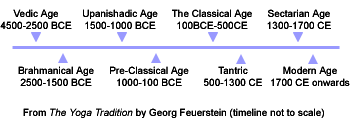A Brief History of Yoga |
|
|
Yoga is many things to many people. It is Hindu in origin and dates back to circa 3,000 BCE, to India's Indus Valley. Historically, the word yoga is associated with union. Yoga is derived from the Sanskrit word for yuj, meaning to yoke or bind. Yoga is often described as a unity or integration of body, mind and spirit - a united Self.
Yoga strives to unify and balance all aspects of being. The term yogin is used to refer to a male practitioner of yoga and the term yogini is used for a female practitioner of yoga.
The first written account of yoga is a text by Patanjali called The Yoga Sutras of Patanjali (or The Yoga Sutra of Patanjali). Patanjali was an Indian sage (circa 300 BCE to 150BC). The word Patanjali literally means 'a being who falls from the sky into the open palms of a woman'.
Patanjali's yoga sutras (Classical Yoga) are 195 aphorisms or statements—a philosophical handbook—that outlines the basic principles of yoga.
 |
See the Yoga At Home Glossary for more understanding of these Sanskrit words.
See also:


